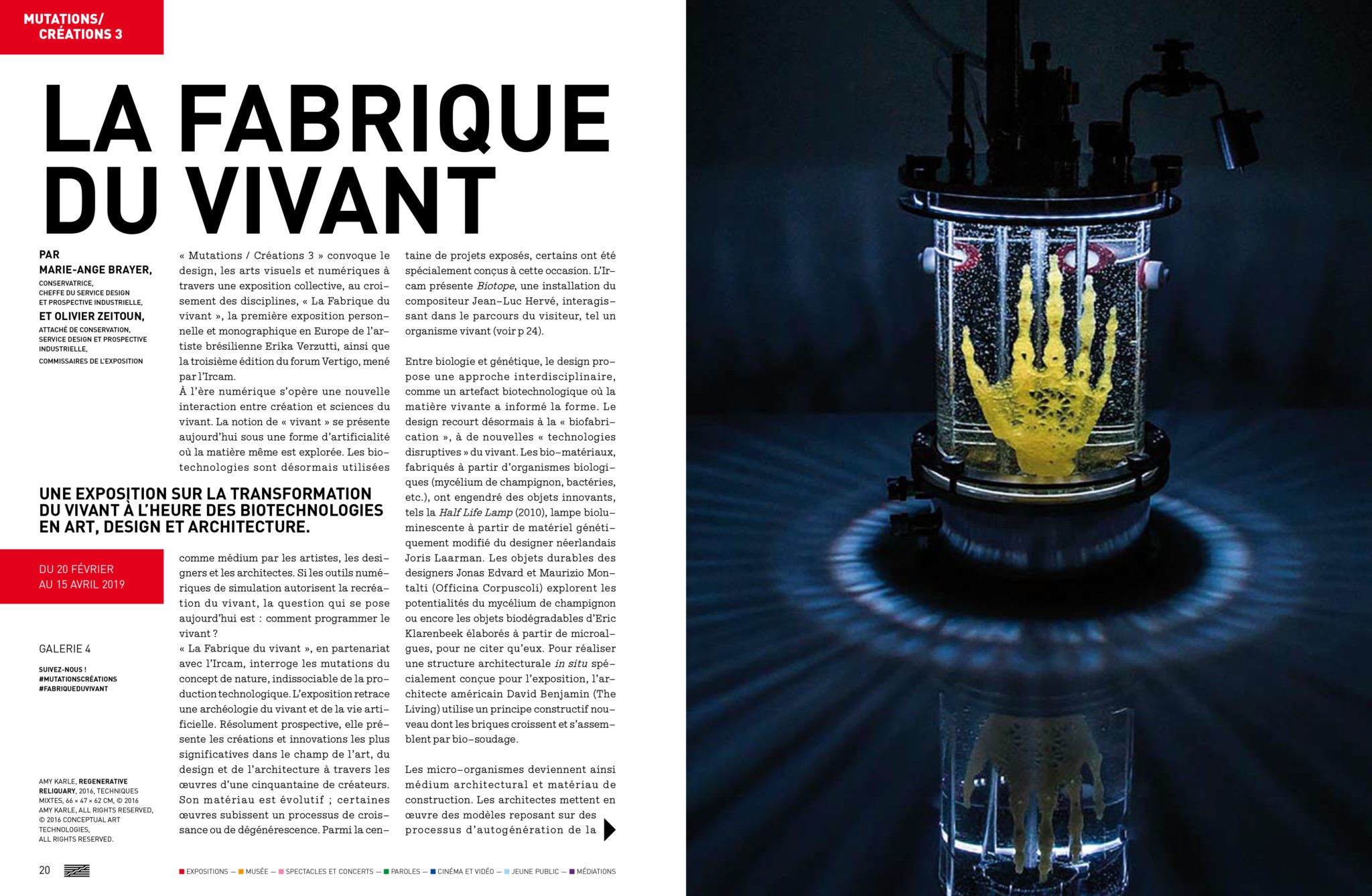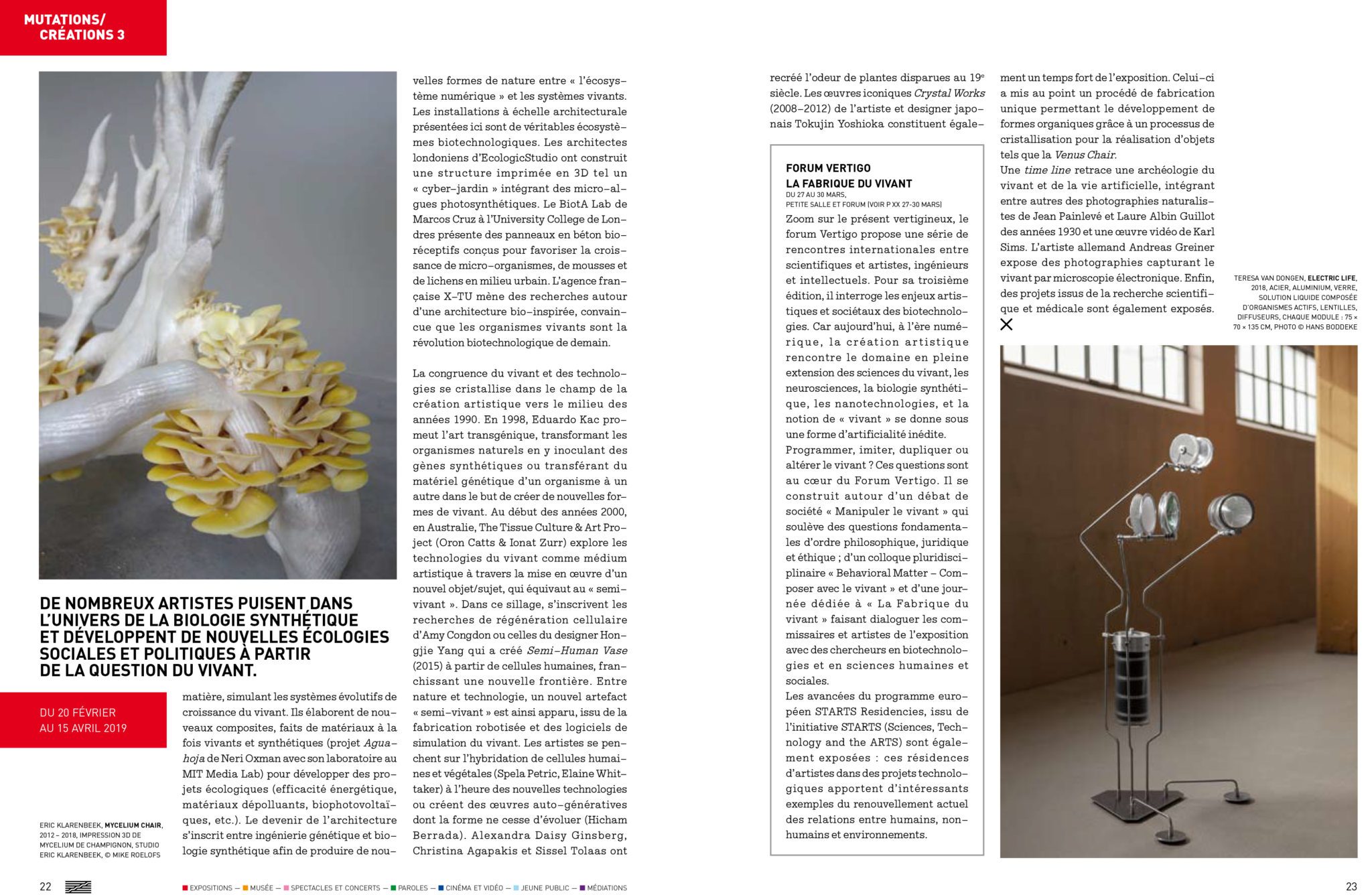La Fabrique du Vivant | Designing the Living
18 February – 15 April 2019
Centre Pompidou
Place Georges-Pompidou
75004 Paris, France
In conjunction with this exhibition, Amy Karle will speak at Forum Vertigo organized with IRCAM on March
La Fabrique du Vivant [The Fabric of the Living] retraces an archaeology of the living and of artificial life. This group exhibition offers a prospective presentation of the recent work of some fifty designers, in addition to research from scientific laboratories. Organized as part of the third edition of the Mutations / Creations cycle, La Fabrique du Vivant, in association with IRCAM. In the digital era, a new interaction is emerging between creation and the fields of life science, neuroscience and synthetic biology. The focus now lies on matter itself. The notion of ‘living’ takes on a new form of artificiality, somewhere between inertia and momentum. The ‘living’ spans the physical field of matter and the immateriality of the digital world. Biotechnologies are now a medium used by artists, designers or architects. Digital simulation tools now allow us to recreate the living. Between biology and genetics, design takes a cross-disciplinary approach, like a biotechnological artefact where living matter dictates the form. Design now turns to ‘bio-manufacturing’ and new ‘disruptive technologies’ around living matter. Bio-materials, made from organic life (fungus mycelium, laminar algae, bacteria and yeasts, etc.) have led to new sustainable, biodegradable objects. Studying the behavior of life (animals or plants) leads to innovative architectural design producing new forms of nature, between the digital ecosystem and living systems. Artists question the links between the living and the artificial, as well as the processes of artificial recreation of life; the manipulation of chemical procedures on living matter; selfgenerating works with ever-changing forms; hybrid works of organic matter and industrial material, or the hybridization of human and plant cells. In this era of digital technologies, artists draw on the world of biology, developing new social and political environments based on the issue of the living. (excerpt from press release).
From the Curators, Marie-Ange Brayer, chief curator, Design et prospective industrielle, Mnam-CCI, Centre Pompidou and Assistant Curator Olivier Zeitoun, curator at the Mnam-CCI:
The notion of “alive” crosses as much the intangible field of computing and digital technologies as the physical field of matter. Biotechnologies are now used as a medium by artists, designers or architects. Since digital tools of generative simulation allow recreating life, the question that arises today is: How to program the living? The simulation of natural phenomena now combines with digital manufacturing techniques.


from “Code Couleur”, the magazine of the Centre Pompidou
Organized by Marie-Ange Brayer, chief curator of the department of design and industrial perspective, and Olivier Zeitoun, deputy curator, this prospective exhibition will bring together about forty creators, designers, architects, international artists as well as scientists deeply involved with these issues as part of the new platform entitled “Mutations / Creations”, where artistic creation, science, and industrial fields meet, the Centre Pompidou is preparing an exhibition on the transformation of the living at the time of biotechnologies in art, design
Mutations / Creations is the annual creation and innovation laboratory at the Centre Pompidou, exploring the ties between arts, science, engineering
Curators Marie-Ange Brayer, Curator, Head of the Design and Industrial Prospective Department Olivier Zeitoun, Conservation Manager, Design and Industrial Prospective Department Catalogue Artists, Designers and Architects of the show: Shamees Aden ; Laure Albin Guillot ; François Azambourg ; Heather Barnett ; Sonja Bäumel and Manuel Selg ; BCL (Georg Tremmel + Shiho Fukuhara); Hicham Berrada ; Burton Nitta (Michael Burton and Michiko Nitta) ; Julian Charrière ; Natsai Audrey Chieza ; Carole Collet ; Amy Congdon ; Marcos Cruz and Brenda Parker (Bio-ID, UCL) ; The Disease Biophysics Group from Harvard University ; Alexandre Echasseriau ; Jonas Edvard ; Alexandra Daisy Ginsberg, Christina Agapakis and Sissel Tolaas ; Lia Giraud ; Guillian Graves (Big Bang Project) ; Andreas Greiner ; Ernst Haeckel ; Perry Hall ; Jean-Luc Hervé ; Marlène Huissoud ; Eduardo Kac ; Amy Karle ; Allison Kudla ; Joris Laarman ; The Living (David Benjamin) ; Julia Lohmann ; Julian Melchiorri ; MIT Media Lab (Cindy Hsin-Liu Kao) in collaboration with Microsoft Research ; Mogu ; Isaac Monté ; Gabriela Munguia ; Officina Corpuscoli ; Neri Oxman & The Mediated Matter Group, MIT ; Jean Painlevé ; Claudia Pasquero and Marco Poletto (EcoLogicStudio) ; Institut Pasteur ; Špela Petric ; PILI (Marie-Sarah Adenis) ; Pamela Rosenkranz ; Daan Roosegaarde ; Karl Sims ; Studio Formafantasma (Andrea Trimarchi and Simone Farresin) ; Studio Nienke Hoogvliet (Nienke Hoogvliet) ; Studio Klarenbeek & Dros ; Studio Libertiny (Tomas Libertiny) ; The Tissue Culture & Art Project (Oron Catts & Ionat Zurr) in collaboration with Robert Foster ; Samuel Tomatis ; Urban Morphogenesis Lab (The Bartlett UCL) ; Tim van Cromvoirt ; Teresa van Dongen ; Elaine Whittaker ; Worcester Polytechnic Institute ; Wyss Institute from Harvard University ; XTU Architects (Anouk Legendre and Nicolas Desmazières) ; Hongjie Yang ; Tokujin Yoshioka

